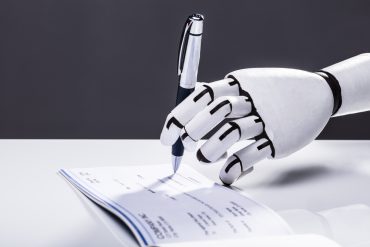
Most researchers agreed that AI will outperform humans in a number of tasks within the next 10 years, such as translating languages by 2024, writing high school-level essays by 2026, and driving a truck by 2027.
As much as we like to joke about the day that artificial intelligence (AI) advances beyond the human brain—from Skynet to Hal to “robot overlords”—we have a surprisingly difficult time predicting when, exactly, that exchange is going to happen.
But, considering that AI is inevitably going to have massive social and political consequences— particularly in the way we move around, treat diseases, advance science, conduct business, and even go to war—it seems best that we prepare our public policies accordingly.
That, at least, is the philosophy behind a recent study and subsequent paper titled “When Will AI Exceed Human Performance? Evidence from AI Experts,” written by Katja Grace from the Future of Humanity Institute at Oxford University, plus others from AI Impacts and Yale University’s Department of Political Science. The paper, which is freely available on arXiv.org, was the result of a survey of 352 AI academics, experts, and researchers who published at the 2015 International Conference on Machine Learning and the Neural Information Processing Systems conference in the same year.
Artificial intelligence trends
Grace and her co-authors defined this moment when AI becomes more capable than the human brain as “high-level machine intelligence” (HLMI), which is achieved “when unaided machines can accomplish every task better and more cheaply than human workers.”
Respondents were asked to estimate the probability of HLMI arriving in the future, and the study found that the aggregate predicted a 50% chance of HLMI occurring within 45 years. When you reduce the window to only 9 years, the chance of HLMI occurring drops to 10%. By the time 2117 comes around, respondents predict there’s a 75% chance of AI having met this important milestone.
The paper pointed out that cultural differences—what they describe as “inter-subject variation”—can have a major impact on this number. In short, those from Asian countries predict that HLMI will arrive a full 44 years earlier than those living in North American countries. Europeans were comfortably in the middle of the two extremes, with other regions weighted slightly toward believing that HLMI will arrive sooner than later.
Interestingly enough, the study found that age and expertise (as in their number of citations) had no meaningful effect on how they predicted the arrival of HLMI. But, the differences in these numbers prove the paper’s point that further discussions—preferably cross-cultural—are necessary.
What HLMI means for labor
Respondents were then asked about the implications of HLMI when it comes to human labor, ranging from playing Angry Birds to the full automation of all human jobs. In short, most researchers agreed that AI will outperform humans in a number of tasks within the next 10 years, such as translating languages by 2024, writing high school-level essays by 2026, and driving a truck by 2027.
Even though many believe that AI will only be able to successfully accomplish jobs that are “low-skill” or require very little in the way of creativity or thinking on one’s feet, those surveyed for this study seem to agree that essentially every job could be accomplished by AI, given enough time. An AI retail salesperson is less than two decades away, and the capacity to write a New York Times best-seller is roughly 30 years away, according to the median estimates. Even a surgeon—one of the most revered and difficult professions—could be replicated by 2053 if predictions hold true.
Technological unemployment?
And what about the “full automation of human jobs” breaking point? Most experts predict it will be nearly 125 years before AI completely takes over. That might seems like a long time from now, but given the rapid pace of change within the field, it might come sooner than many think. In fact, 67% of respondents said progress has moved faster in the second half of their careers.
That plays precisely into how quickly these numbers can change based on breakthrough research. Back in 2015, when these experts were asked about when an AI would be capable of beating a human opponent in Go—an ancient strategy game in which each player tries to surround their opponent on a 19×19 board—the median prediction was 12 years, or roughly 2027. Google’s AlphaGo did it in just 2 years, and is now “retiring” after soundly beating all of the world’s most accomplished players.
Just goes to show how quickly the AI landscape can change. That has some experts worried, but most are optimistic about the inevitable AI-driven future. The median probability for a “good” outcome was 25%, while the probability of an “extremely bad” outcome, as in the extinction of humanity, landed at 5%—either reassuringly low or surprisingly high, depending on whether you’re a glass half-full or -empty kind of person.
The paper wasn’t meant to inspire any particular policy changes at the moment, but rather provide a baseline for further discussion and research into the timeline for AI’s rise in the years and decades to come. If anything, the study showed that even the experts can’t agree on when—if at all—AI is going to take center stage.



























